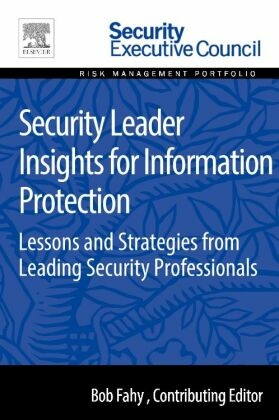Security Leader Insights for Information Protection - Lessons and Strategies from Leading Security Professionals
| Verlag | Elsevier Books |
| Auflage | 2014 |
| Seiten | 74 |
| Format | 15,6 x 0,2 x 22,9 cm |
| Gewicht | 150 g |
| Artikeltyp | Englisches Buch |
| ISBN-10 | 0128008431 |
| EAN | 9780128008430 |
| Bestell-Nr | 12800843EA |
How do you, as a busy security executive or manager, stay current with evolving issues, familiarize yourself with the successful practices of your peers, and transfer this information to build a knowledgeable, skilled workforce the times now demand? With Security Leader Insights for Information Protection, a collection of timeless leadership best practices featuring insights from some of the nation's most successful security practitioners, you can.
This book can be used as a quick and effective resource to bring your security staff up to speed on security's role in information protection. Instead of re-inventing the wheel when faced with a new challenge, these proven practices and principles will allow you to execute with confidence knowing that your peers have done so with success. It includes chapters on the collaboration between corporate and information security, emerging issues in information protection, and information protection regulations and standards.
Security Leader Insights for Information Protection is a part of Elsevier's Security Executive Council Risk Management Portfolio, a collection of real world solutions and "how-to" guidelines that equip executives, practitioners, and educators with proven information for successful security and risk management programs.
Inhaltsverzeichnis:
Part 1: Strategies for Collaboration between Corporate and Information Security
1. Security and Information Technology Alignment
Learn how security can benefit from existing information technology policies and explore new security and information technology collaborations.
2. Moving Beyond Convergence
Forget the dated and ineffective term convergence and move to clearer ways of describing how to bring business units and technologies together to better address and manage risk.
3. What Are the Characteristics of a Good Relationship Between Corporate Security and Information Security?
Learn how to develop a positive relationship between corporate security and information security with these suggestions from experienced security professionals
Part 2: Emerging Issues in Information Protection
4. Mobile Insecurity
Tips and tricks to develop effective security policies that help safeguard mobile assets.
5. Security in Cloud Computing: How Is It Diff erent?
Four experts compare security issues in cloud computing with those commonly found in more traditional outsourced services.
6. The Risks of Web-Based Applications in the Workplace
Three distinguished security professionals share their experiences with the use of web-based applications in the workplace.
7. Leveraging Information Lifecycle Management for Convergence and Compliance
A primer on how to leverage information lifecycle management for security convergence and the protection of information assets.
8. Preventing Identity Theft by Protecting Your Data
Learn how to protect your company from data breaches with these security strategies.
9. Protecting Your Company's Intellectual Property
Four experts share tips for protecting corporate intellectual property through risk management policies and procedures.
Part 3: Information Protection Regulations and Standards
10. The PCI Data Security Standard: Compliance Lessons Learned
One exper ienced security executive shares advice for implementing the Payment Card Industry (PCI) Data Security Standard (DSS).
11. Is Your Data Leaking?
Protect your company's data with these tips for making sure data doesn't leave the organization in an unauthorized way or, when authorized, in an insecure way.
12. Aiming for National Cybersecurity
Experienced security professionals discuss recent cybersecurity breaches and call for increased public-private collaboration for national cybersecurity.
13. Understanding the FRCP's eDiscovery Rules
Demystify the Federal Rules of Civil Procedure (FRCP) and learn how to protect your company's electronically stored information with these steps for compliance.

